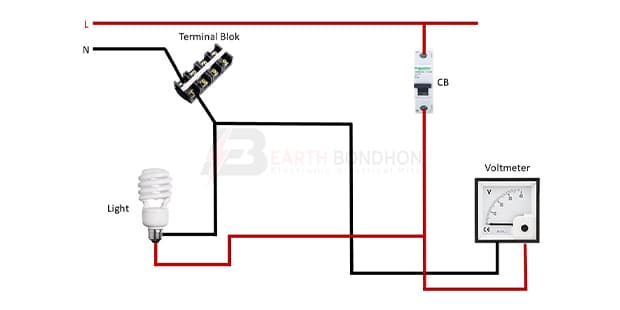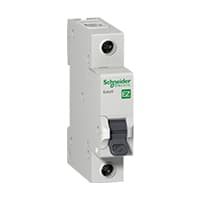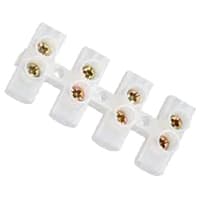Voltmeter Connection Diagram:
This diagram shows how to make Voltmeter Connection Diagram. In this circuit, we use a single-phase voltmeter, an SP MCB ( Single Pole Miniature Circuit Breaker ), a terminal block, and a light. First, we need to input the phase connection to SP MCB, then input the connection to the voltmeter from SP MCB, then input the phase connection to light, then input a neutral connection to the terminal block. And lastly, input the neutral connection to the light from the terminal block.
Advertisements
Components needed For this Project:
You can get the components from any of the sites below:
- single phase Volt Meter [See Buy Click Amazon]
- SP MCB 20A [See Buy Click Amazon]
- Terminal Block [See Buy Click Amazon]
- Well LED Light (20w) [See Buy Click Amazon]
*Please note: These are affiliate links. I may make a commission if you buy the components through these links. I would appreciate your support in this way!
Advertisements
Components used to make the Voltmeter Connection Diagram:
An instrument that measures the potential difference between any two points in a circuit directly in volts is called a voltmeter. A voltmeter is an Electrical instrument that directly measures the potential difference between any 2 points in a circuit in volts. The voltmeter is connected in parallel with the 2 points in the circuit where the potential difference is to be measured. This instrument consists of a galvanometer. Like an electric cell or an ammeter, a voltmeter has 2 terminals, a positive and a negative terminal. Usually, the positive end is red and the negative end is black.
02. SP MCB:
In single-pole MCB, Switching and protection are Affected in only one Phase. Single phase supply to break the phase only. A single Pole breaker is Typically used with 120-volt Circuits, and a 6-20 amps Miniature Circuit Breaker. They are constructed with one Line Wire and one Neutral wire. A Single Pole switch is the most basic General-Purpose switch that you use to Control a light or another device from one location. These Switches have 2 Brass-Colored screw Terminals Connected to the hot Power source wires. Pole refers to the number of Circuits Controlled by the Switch SP Switches Control only one Switch Electrical Circuit.
Terminal Clocks are Connectors That Terminate a Single wire and Connect it to a circuit or other system. Terminal Blocks come in a range of shapes, Sizes, and ratings, but Always Terminate a single Wire and are Never multi-pole. Terminal Blocks are used to Secure or Terminate Wires and, in Their Simplest form, Consist of Several Individual Terminals Arranged in a long strip system. Terminals are Useful for Connecting the Wiring to the GND or, in the Case of Electrical power, for Connecting Electrical Switches and Outlets to the Mains side.
04. Light:
CFL stands for Compact Fluorescent Lamp which is an improved version of tube lights of earlier days. Like tube lights, it is a vacuum glass tube with fluorescent powder coating which is not as long and straight as tube lights but curved/twisted compact, or small in size. Like a tube light, it has electrodes or filaments at both ends. But in this case, instead of a choke, there is an electronic circuit that drives the Compact Fluorescent Lamp. Because the red wave is less in the light of the Tubelight and Compact Fluorescent Lamp, the object looks a little pale or the correct color of the object does not appear.
Thank You for visiting the website. Keep visiting for more Updates.
Frequently asked questions
The voltmeter is connected in parallel with the circuit diagram. This means that the voltmeter does not draw any current from the circuit diagram and thus does not affect the voltage measurement. The voltmeter is connected to the 2 points in the circuit where you want to measure the voltage drop.
A voltmeter is a galvanometer with high resistance. It measures potential drop across any part of an electrical circuit diagram. It is connected in parallel so that it does not draw any current itself (due to high resistance) and does not affect the net resistance of the circuit.
If connected in series with the load the overall resistance of the circuit diagram will become very high (infinite in the ideal voltmeter case). Due to this high resistance, the current diagram flowing in the circuit diagram will tend to zero i.e. become very low.
Voltmeter resistance is very high, when connected in series, it makes the effective resistance of the circuit very high. Due to this, the current in the circuit becomes extremely small. Since the ammeter measures the current, hence the deflection of the ammeter is almost zero.
In a series circuit diagram, the sum of the voltages across components is equal to the power supply voltage. In a series circuit diagram, the voltages across each of the components were in a similar proportion to their resistances. This means that the power supply voltage divides equally if 2 similar components are connected in series.
Read more Single Phase Wiring
What is a kilowatt-hour (kWh) | kwh formula | What does kwh mean
Introduction to Electrical Units and CircuitskW and kWh on your electricity bill As your home uses electricity during...
What is the Difference Between kVA | What does KVA mean | kVA formula
Difference Between KVA ExplainedWhat does KVA Mean? There are technical terms aplenty when it comes to generators, and...
Power Factor | Power Unit | Energy | Electricity Unit
Power factor definition | Calculating Power FactorPower Factor Values In a purely resistive circuit, the power factor...





0 Comments